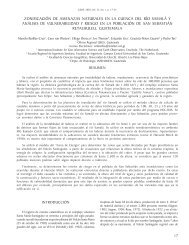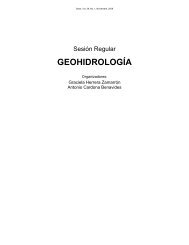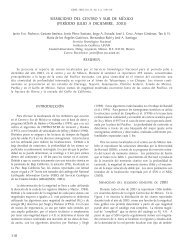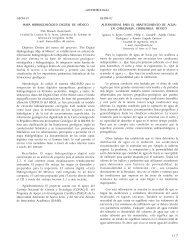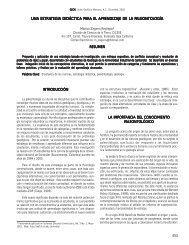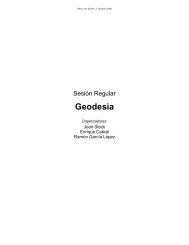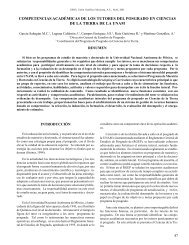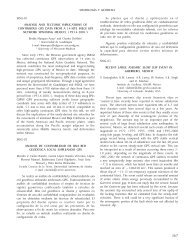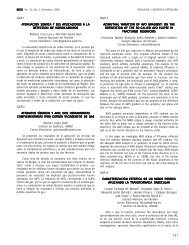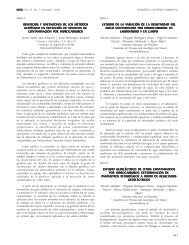<strong>GEOTERMIA</strong>además se encuentran en contacto con fases orgánicas. La presenciade compuestos orgánicos en la muestra ocasiona que lareproducibilidad de los métodos disminuya.En este trabajo se presenta una metodología de purificación demuestras de agua hipersalina de acuíferos profundos subyacentes alpetróleo. También se presentan resultados de las mediciones deoxígeno-18 y deuterio realizadas a muestras salinas sintéticas ymuestras de acuíferos profundos.GEOTER-11EFFECTIVE THERMAL PROPERTIES OFGEOTHERMAL CEM<strong>EN</strong>TING SYSTEMSA. García 1 , J.M. Morales 2 , E. Contreras 1 , G. Espinosa 3 and E.Santoyo 41Instituto de Investigaciones Eléctricas2Centro Nacional de Investigación y Desarrollo Tecnológico3Depto. de IPH, UAM, Iztapalapa4Centro de Investigación en Energía, UNAMThe effective thermal conductivity and diffusivity and specificheat capacity of six cementing systems used in geothermal wellconstruction were determined experimentally in the temperaturerange of 25°C to 220°C. Measurements were carried using theclassical line source method and Jaeger’s variant of the method.Correct operation of the experimental system was checkedmeasuring the thermal properties of fused quartz samples and aprocedure was developed for preparation of the cement samples.Results show that thermal conductivity and specific heat capacitydepend on the particular cement system and tend to increase with anincrease in temperature for most systems while thermal diffusivitydecreases with temperature for most systems. Thermal conductivityuncertainties were 3.5% and 9.4% for the line source and Jaeger’smethods, respectively, while thermal diffusivity uncertainties were13.3% using Jaeger’s method.GEOTER-12MEDICION DE CONDUCTIVIDAD TERMICA DELIQUIDOS APLICANDO <strong>LA</strong> TECNICA DE <strong>LA</strong>ESFERAGarcía-Manuel Pablo, Contreras-López Enrique y García-Gutiérrez AlfonsoGerencia de Geotermia, Instituto de Investigaciones EléctricasEn esta investigación se presenta una metodología para ladeterminación de la conductividad térmica de líquidos simples acondiciones ambientales de presión y temperatura. Además, sedescribe el funcionamiento de un equipo experimental para realizarlas mediciones; el cual ya fue probado en operación.La aportación que se realiza con esta investigación se enfocóen el área de desarrollo de infraestructura tecnológica nacional;específicamente en las áreas de Ingeniería Mecánica, IngenieríaSolar, Procesos Químicos, Generación de Electricidad por FuentesAlternas y todos aquellos procesos en donde se requiera lacaracterización de las propiedades termofísicas, que actualmente sonimprescindibles y de costo elevado en cualquier parte del mundo;por todo esto, se justifica la realización de este trabajo.La técnica que se aplicó para realizar las mediciones en estainvestigación es la técnica transitoria de la esfera del NationalInstitute of Standards and Technology (NIST antes NBS), la cualemplea un termistor que se utiliza como sensor de temperatura ycomo elemento calentador de la muestra que se desea evaluar.El equipo experimental consta de 4 elementos principales: unacomputadora personal, una tarjeta electrónica multifuncional, uncircuito integrado y un termistor. La computadora controla todo elproceso; ésta se encarga de controlar a los tres elementos restantes,su función principal es la de controlar a la tarjeta electrónicadurante las mediciones; la tarjeta a su vez, tiene dos funcionessuministrar pulsos de voltaje al circuito integrado y medir la caídade voltaje a través de la resistencia del termistor. El circuitointegrado es un convertidor Voltaje-Corriente que se utiliza paracalentar a la resistencia del termistor. El termistor es el elementofinal del equipo, éste mide la temperatura y calienta a la muestra quese desea analizar.La investigación se divide en cuatro rubros, estos son: 1. Lacalibración Temperatura-Resistencia del termistor, lo cual tiene lafinalidad de conocer una ecuación de calibración que se utilizadurante las mediciones; 2. La caracterización del circuito integrado,que tiene como finalidad la determinación de una relación entre elvoltaje de suministro de la computadora y la corriente que se envíaal termistor; 3. La calibración de las propiedades efectivas deltermistor, lo cual tiene la finalidad de determinar los valores delradio y el inverso de la conductividad térmica del termistor, valoresque se utilizan posteriormente en la medición de conductividadtérmica.Se obtuvieron dos resultados de mediciones de conductividadtérmica a 26.1°C y a presión ambiental, las sustancias evaluadasfueron la acetona y el metanol, para la primera se encontró unadiferencia de menos del 4.2%, mientras que para el metanol, ladiferencia obtenida fue de menos del 13.7%.Por otra parte, se efectuó un análisis de incertidumbre delequipo de medición, el análisis se realizó según las especificacionesde Bevington R. P., “Data Reduction and Error Analysis for thePhysical Sciences”, Editorial McGraww-Hill Book Company, pp.56-74; y de la “Guía BIMP/ISO para la Expresión de laIncertidumbre en las Mediciones”, Centro Nacional de Metrología:Dirección de Metrología Eléctrica, Reporte Técnico Número CNM-MED-PT-0002, Los Cués, Querétaro, México, 1994, pp. 27-28. Deeste estudio, se encontró una incertidumbre expandida de ±0.00234 W/m°C en las mediciones de conductividad térmica.GEOTER-13GEOTRANS: A COMPUTER CODE FORESTIMATING TRANSI<strong>EN</strong>T TEMPERATURES INTHE COMPLETION OF GEOTHERMAL WELLSWITH DRILLING FLUID <strong>LOS</strong>SESAlfonso Garcia 1 , Gilberto Espinosa 2 , Edgar Santoyo 3 , PedroMendoza 1 and Isaias Hernandez 41Instituto de Investigaciones Electricas2Depto. de IPH, Universidad Autonoma Metropolitana3UNAM, Centro de Investigaciones en Energia4Instituto Tecnologico y de Estudios Superiores de MonterreyThe GEOTRANS computer code is described. It consists of anumerical simulator and a user interface for data input and analysis260
<strong>GEOTERMIA</strong>of results. The equations governing the dynamic heat transferprocesses in a geothermal well under construction in the presence oflost circulation are solved. They describe flow of fluid in thedrilling pipe and annulus, heat transfer in the drilling pipe metalwall and conductive and convective heat flow in the formation.Solution allows estimation of temperatures in and around a well asfunction of time and vertical and radial position. The model isclosed using heat transfer and fluid friction correlations. Physicalproperties of drilling fluids (muds and water/air mixtures), cements,rocks and pipes, implemented via numerical routines or as databasescomplement the model. Numerical solution follows implicit finitedifferences and the Thomas algorithm is used for their solution Heattransfer in the formation is 2D and is solved via an ADI scheme. Aunique feature of GEOTRANS is that it simulates drilling fluidlosses at any position along the uncased wellbore and its effect isaccounted for as thermal convection in the formation. GEOTRANSoperates under Windows and data input can be done from a file,interactively or from the databases implemented. Program executionis controlled from the user interface. Data post-processing includesautomated plotting of simulated temperatures as function of depthand time for the circulation and shut-in periods. Previous codevalidation was performed by comparison against data from theliterature and analytical solutions. Results of application to theMexican well H-26 from the Los Humeros geothermal field arepresented. The shut-in logged temperatures were reproduced in thepresence of lost circulation. GEOTRANS can be used to estimateformation temperatures and formation porosity by trial and error.GEOTER-14 CARTELRESPUESTA DE <strong>LOS</strong> MECANISMOS FOCALES <strong>EN</strong>EL CAMPO GEOTERMICO <strong>LOS</strong> HUMEROS,PUEB<strong>LA</strong>Angel David Hurtado Artunduaga y Javier F. LermoSamaniegoInstituto de Geofísica, UNAMLa actual sismicidad en el campo geotérmico Los Humeros hasido registrada en tiempo real desde 1997. Y se piensa que laprincipal causa de su ocurrencia fue la puesta en marcha de dospozos reinyectores (H29 y H38) en el yacimiento. Hasta Octubre de1999 se han procesado alrededor de 100 eventos sísmicos, entre loscuales 33 han respondido como datos fuente para realizar un estudiode mecanismos focales que indicarían la dirección de los esfuerzosprincipales que ocasionan dicha sismicidad. Esta herramienta,paralelamente desarrollada con estudios geológicos y deyacimiento, han arrojado resultados de falla normal con direccionesde plano principal hacia el NNW y NE y buzamientos superiores alos 50° al W y E, a profundidades entre 1200 y 2900 m. Es muyprobable que la actual dirección de los planos de falla, los cuales seconsideran reactivados por causa de dichos pozos reinyectores,estén siendo usados como camino de recarga hacia el yacimiento.De igual forma, se piensa que el efecto térmico que ejerce esta aguareinyectada (60°C, aproximadamente) y la explotación misma delyacimiento, estén afectando la presión de poro del medio fracturado,lo cual estaría generando un cambio volumétrico del sistema queconllevaría entonces a desestabilizar el campo de esfuerzosprevaleciente antes de la reinyección.Hasta este momento los mecanismo focales han servido parapostular las direcciones principales del campo de esfuerzos y dar piea postular entonces dichas causas de la sismicidad.261


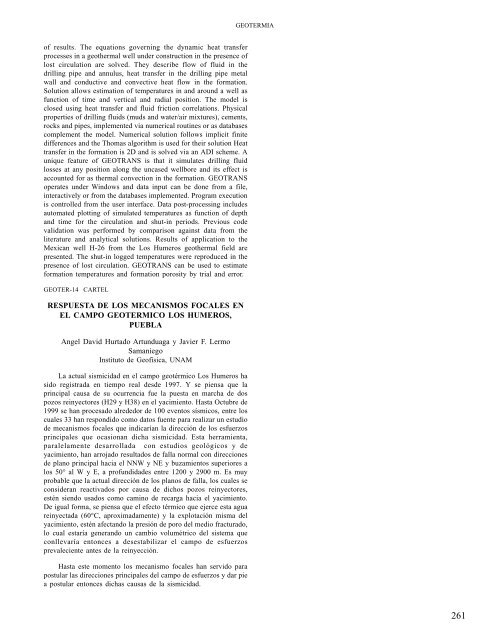
![Libro de resúmenes [revisión final, 172 páginas] - UGM](https://img.yumpu.com/51565067/1/190x245/libro-de-resamenes-revisian-final-172-paginas-ugm.jpg?quality=85)
